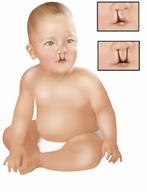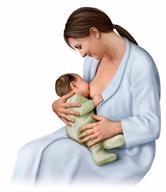Breastfeeding Your Baby With a Cleft Lip or Cleft Palate

A cleft lip is an opening in the upper lip. A cleft palate is an opening in the top of the mouth (palate). Cleft lip and cleft palate are problems that are present at birth (congenital defects). They occur when the upper lip or the palate does not develop completely before birth. Some babies may have both a cleft lip and a cleft palate.
Breastfeeding a baby with a cleft lip or palate may be challenging. The seal of the mouth against the breast draws milk out of the breast and down the throat with each suck. Babies with cleft lip or cleft palate have a harder time making a seal against the breast. This may make it difficult for them to get milk out of the breast. Work with a breastfeeding specialist (lactation consultant) or feeding specialist to help you and your baby overcome this challenge.
How does breastfeeding benefit my baby?
-
Breast milk supports your baby's disease-fighting system (immune system). Breastfeeding can help protect your baby from infections that are more common among babies with cleft lip and cleft palate, such as ear infections.
-
Cleft lip and cleft palate are often repaired with surgery during your baby's first months. Breastfeeding can help your baby stay healthy for surgery and can prevent infections after surgery.
-
The breast is soft and flexible, and it can mold to your baby's lip and mouth to help create the seal and draw milk from the breast. These qualities may help make breastfeeding easier than bottle feeding.
What actions can I take to help my baby with breastfeeding?

The best thing to do is begin breastfeeding as soon as possible after birth. Remember to be patient. Work with a lactation consultant to find strategies that work for you.
It is important to find a way to breast milk feed that works best for you and your baby. Here are some tips for breast milk feeding your baby:
Try holding your baby in different positions when putting your baby to breast. It is often easier to feed babies with cleft palates when they are in a semi-upright position. This is because milk is less likely to leak into their noses.
Use your thumb or breast to help fill in the opening in the lip when putting your baby to breast. Doing this will help your baby's mouth form a seal around your breast.
Some babies have cleft lips or cleft palates that are so large that they prevent the babies from being able to breastfeed effectively. If this is the case for your baby, start pumping your milk right away to keep up your milk supply. This will allow you to feed your baby only with breast milk (exclusively breastfeed).
Try using feeding tube devices or specialty bottles with soft, flexible nipples to make sure that your baby gets enough milk. For some babies, a spoon or cup may work better. Your baby's provider or feeding specialist can help you learn how to safely use these devices.
Breastfeeding tips and recommendations
-
Work with a lactation consultant or feeding specialist to find positions, equipment, and breastfeeding strategies that work best for you and your baby.
-
Breastfeed when you feel the need to reduce the fullness of your breasts or when your baby shows signs of hunger. This is called breastfeeding on demand.
- Make sure your baby is getting enough milk by counting their wet diapers and poop. Signs that your baby is getting enough milk include:
-
If your baby has difficulty getting milk from the breast, you will need to pump milk for your baby.
-
If you are pumping breast milk for feeding, pump regularly. Doing this can help to keep up your milk supply.
-
Make sure your baby is gaining a healthy amount of weight. Talk with your baby's provider or lactation consultant about how much weight your baby should be gaining.
-
Avoid giving your baby water or solid food before they are 6 months old, unless told by your baby's provider.
Contact a health care provider if:
This information is not intended to replace advice given to you by your health care provider. Make sure you discuss any questions you have with your health care provider.

